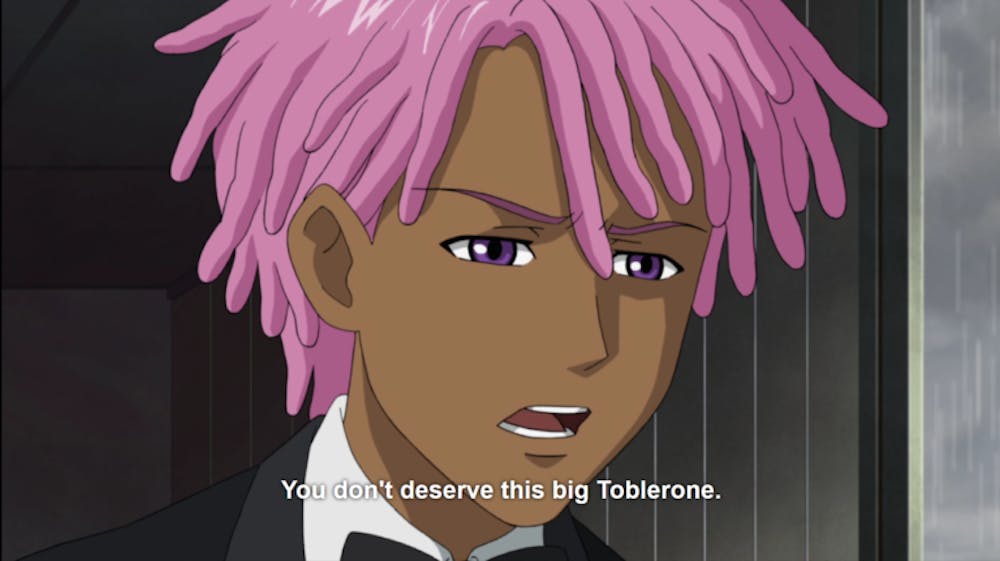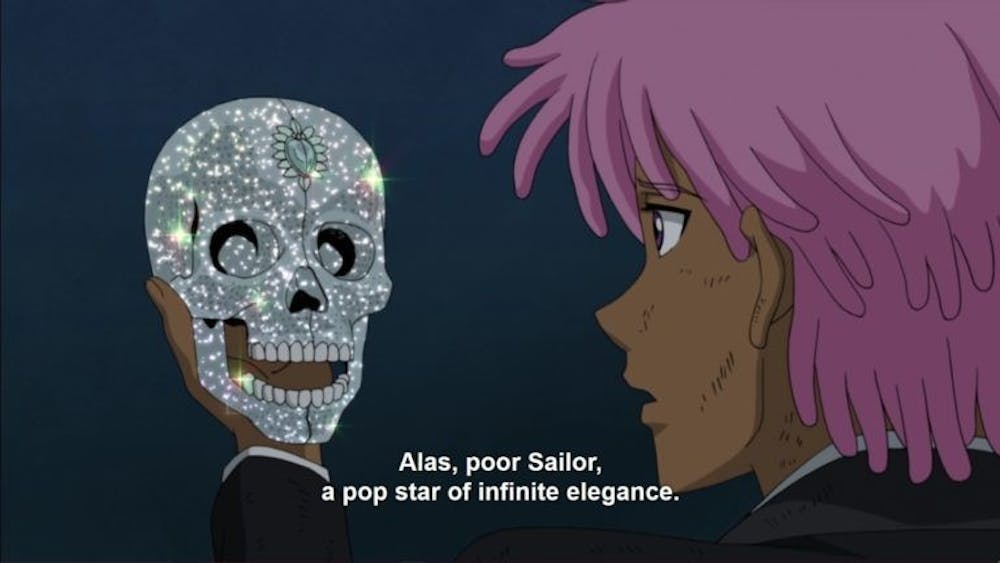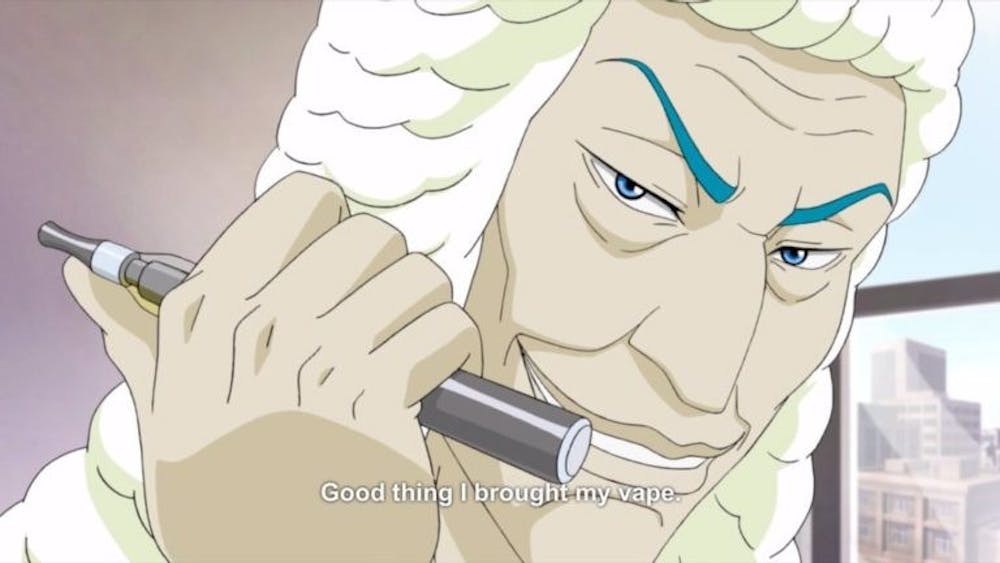There’s something fascinating about shows, games, movies, or songs that manage to achieve the coveted title of “so bad, it’s good.” These masterful trainwrecks try to reach great heights, but through poor execution of every single aspect they crash back down to Earth. Classics such as Tommy Wiseau’s The Room find fame through infamy, and fanbases of ironic enjoyment are created around these genuinely bad pieces of media. Neo Yokio has been tagged with this banner of badness, and aside from some moments that are just terrible, it deserves it.
A narrative that wants to be Ralph Lauren, but is more Kmart
Neo Yokio revolves around Kaz Kaan (voiced by Jaden Smith), a member of Neo Yokio high society. He does everything a rich young person is expected to do. Kaz wears the freshest clothes, knows the coolest dudes, hangs out with the hottest babes, and purchases excessive amounts of Toblerone. Kaz discovers throughout the show that not everything in Neo Yokio is all it’s cracked up to be. On top of these problems Kaz has to contend with his duty as a Magistrocrat, a member of high society who hunts the demons prowling around Neo Yokio. The twist of it all is that the demons really haunting Neo Yokio aren’t the ones possessing school girls and crystal skulls, but the traditions and culture corrupting Neo Yokio high society itself.

Image from Neo Yokio
Neo Yokio should be admired for its attempts to tackle such a difficult subject matter. Some of the most interesting aspects of the plot of the show revolve around how dumb and mundane the problems Kaz Kaan faces really are. The second episode has a major plot point of Kaz’s tux being the wrong color, and the third episode has the brave hero stopping evil villains from breaking the dress code at a prep school. The way the writers exaggerate these issues seems a bit ridiculous at first, but once the chips are down and Kaz learns the truth about Neo Yokio high society, it makes more sense. Now, whether these issues being exaggerated is intentional for the narrative or just because of bad writing is the real problem.
The biggest problem with Neo Yokio’s story comes from its lack of coherent structure. The show tries its darndest to maintain a cohesive narrative throughout the season, but fails miserably. The episodes don’t feel connected all that much, aside from one or two plot points carried over from a previous episode. The worst example of this is between episodes 4 and 5, where a cliffhanger ending in episode 4 is paid off with a jarring, unnecessary time skip. The episodes don’t flow together like an actual narrative, even though they desperately try to. The first episode also feels like it’s from a completely different show when compared to the rest of the season. The ideas are all there for a genuinely interesting story, but the show is missing too many pieces to be considered a complete picture.
The trendy style of perfectly bad writing and voice acting
The writing in Neo Yokio is the show’s best and worst part. It’s hard to describe just how bad the writing really is. It was so bad that it wasn’t clear if the writer was trying to intentionally write some of the most bizarrely terrible lines they could, or if there was an attempt at quality that just happened to fail horribly. It’s like the writers told modern day philosophy genius Jaden Smith to say the most profoundly dumb things he could think of, then constructed a show around those quotes. The first episode certainly feels like that, with such classic lines as: “who cares what time it is when the future is an interminable abyss of wackness?” Every character is given one note to play, and boy oh boy, do they play their notes with little to no development over the course of the series. Some lines are so bad and out of place it’s almost unbelievable – particularly ones that involve Kaz’s weird obsession with Toblerone. The number of shockingly bad lines is probably equal to the number of fashion designers Kaz talks about, and he talks about a lot of fashion designers.
The strangest part about the writing is that it works. All the dumb philosophy, hamfisted social commentary, and just straight up horrible lines are delivered so questionably that it ascends from awful to perfection. The stranger and more out-of-place the line is, the more laughter and enjoyment the show provides. There are some lines that are awkward enough to induce facepalms so hard the viewer’s cranium caves in, but there’s so much obvious heart and effort put into them that they make the viewer smile and go into slightly confused giggle-fits instead. The last episode is the only one in which there aren’t enough funny bad lines and the writing’s truly terrible starts to show itself, but that’s only one out of six episodes.

Image from Neo Yokio
Enhancing the writing is, of course, the stellar voice cast. Well, stellar in the same way a space-themed child’s bedroom is stellar. The voice work is just terrible. Aside from Aunt Agatha, there’s not a single side character that delivers their lines in a way anywhere close to good. The casting director either chose people with the worst accents at a comedy club on a Tuesday evening when only drunk people stumble in, or people with genuine accents that happen to sound like caricatures of real accents. Every time a new character with an even worse voice joined the show it just got better and better. The worst offender is Sailor Pellegrino, whose southern accent is like if nails on a chalkboard could have a southern drawl. The line reads were probably the biggest source of unintentional comedy in the whole show.
The crown jewel on the tinfoil trash crown is the lead, Jaden Smith. Smith is perfectly cast as Kaz Kaan, a rich kid who grew up insulated and naive to how society really works. Now, historically, mixing Jaden Smith and acting was akin to mixing gasoline and a flamethrower. Anyone who has seen After Earth has seen Jaden Smith in a leading role and will immediately assume the worst. Surprisingly, Smith honestly does a good job voicing Kaz. Only he could deliver lines like “my existential dread has been acting up today” so genuinely to that it doesn’t sound stupid and out-of-place. He’s also one of the few voice actors that actually improves throughout the duration of the show. Given some more time, he might actually become a pretty good voice actor. For the time being though, he’s only good because everyone else is so, so bad.
Stylish art and strange music take second place in a beauty contest
The biggest shock of Neo Yokio is that the art style is actually pretty good. Western anime typically struggles from not being able to capture what makes actual Japanese anime visually impressive, and tends to just look like a cheap imitation. Neo Yokio doesn’t escape all of these problems, especially in the first episode, but overall it looks pretty good. Characters are all unique and well-designed (a couple personal favorites being Russian racecar driver Mila Malevich and the Remembrancer). There are also a couple of parts where Kaz is given a weird facial expression for comedic purposes, which is genuinely funny. Is it because the art is good in these cut-aways? Not really, but it’s still entertaining.

Image from Neo Yokio
Animation itself, however, leaves a lot to be desired, especially lip movements that probably needed a few more eyeballs looking over them. Interestingly enough, despite the lip movements and small character movements being choppy and kind of terrible, the action animation is very fluid. The show specifically does chase scenes well, as shown in episodes 3 and 5. There are certainly better looking shows, but for a Western anime exclusive to Netflix, it’s way better than it has any right to be.
The sound work is probably the aspect of Neo Yokio that is the most back and forth between good and bad. The first episode has such ill-fitting music that it’s kind of hilarious, but as the show progresses the soundtrack improves overall. There are still some head-scratching music choices beyond the first episode, but it becomes more consistent and fitting. The best part about the sound work, however, are the random music stings that happen throughout the show. Aside from the writing, these music stings are the best worst part of the show. For example, almost every time the Remembrancer appears on-screen, he’s accompanied by a fantastic music sting. That’s probably the reason he is one of the best characters in the entire show, to be honest. The sound design just adds to the charm of the show.
Featured image from Den of Geek
For more entertainment related content, visit us at Byte Bsu!




















